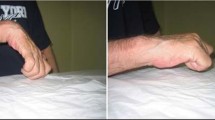Abstract
Botulinum toxin A has been reported to reduce spasticity and increase the comfort of hemiplegic patients. The aim of this study was to assess the efficacy of the treatment on disability, especially in manual activities, and to attempt to identify predictive factors of improvement. Twenty patients (mean age: 54.4 years; M: 14; right hemiplegia: 12) were included, with a delay of at least three months after unilateral hemispheric stroke. Botulinum toxin A (BOTOX®) was injected into the arm adductors (8 cases), forearm flexors (17 cases), pronators, wrist and finger flexors (20 cases), with a total dose of 200 to 300 U. Examination (day 1 and 15, month 2 and 5) consisted of spasticity assessment (modified Ashworth scale), muscle strength, passive range of motion (goniometry), and pain, followed by functional tests, especially the Rivermead Motor Assessment (RMA) and Nine-hole Peg Test (NHPT). Performance in daily living was assessed with the Functional Independence Measure (FIM), and an original analysis of hand grasp, grip and pinches used in domestic activities (9 items), and of comfort of patients and caregivers. Significant reduction in spasticity was observed on the elbow flexors, pronators, wrist and fingers flexors, especially at day 15 (mean 0.90 to 1 point), with wide variations in effect. Muscle strength was increased in wrist and fingers extensors, with concomitant increase in the opening of the thumb to index finger space. There was no effect on the NHPT requiring distal manipulation, but the RMA, which especially concerned picking up and releasing a tennis ball, showed significant improvement. Furthermore, use of the upper limb in daily living increased, particularly for internal grasping of objects, and for grasping by the top, transporting and releasing of objects. Patients and caregivers reported facilitation in dressing, and in proximal and distal care of the upper limb. The global flexor position of the limb improved. Adverse reactions were rare and mostly consisted of transitory pain during injection. The improvement in the RMA was better explained by the quality of the initial motor command on distal prehension (positive correlation with motor strength), and that in hand using in domestic activities by a lower level of spasticity on pronators and wrist flexors (negative correlations with spasticity). Conversely, the severity of the motor deficit (negative correlations with motor strength) and a high level of spasticity before injection (positive correlations with spasticity) mostly explained the improvement in comfort. In conclusion, botulinum toxin A is efficient in improving hand use in patients with relatively preserved distal motricity, and in increasing comfort in patients with severe global disorders.
Similar content being viewed by others
Author information
Authors and Affiliations
Additional information
Received: 22 March 2001, Received in revised form: 28 March 2001, Accepted: 21 May 2001
Rights and permissions
About this article
Cite this article
Rousseaux, M., Kozlowski, O. & Froger, J. Efficacy of botulinum toxin A in upper limb function of hemiplegic patients. J Neurol 249, 76–84 (2002). https://doi.org/10.1007/PL00007851
Issue Date:
DOI: https://doi.org/10.1007/PL00007851




